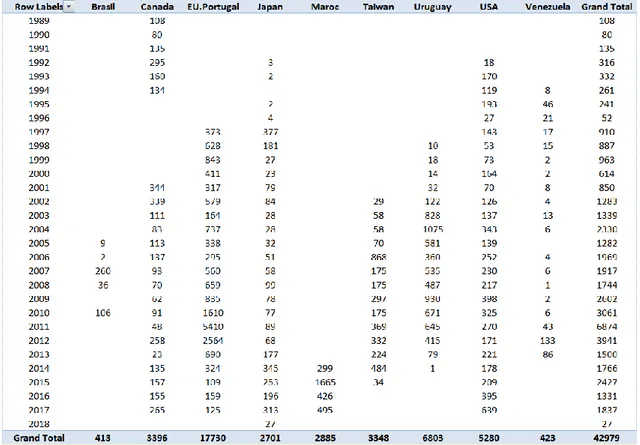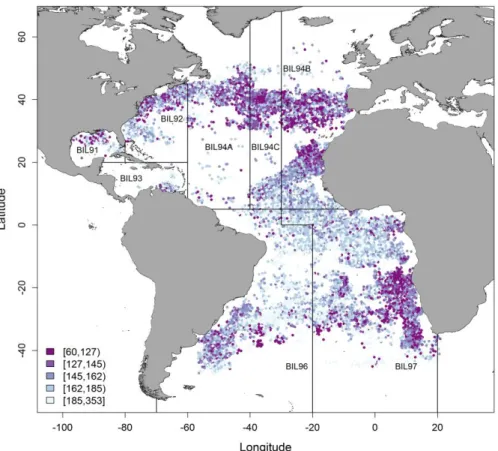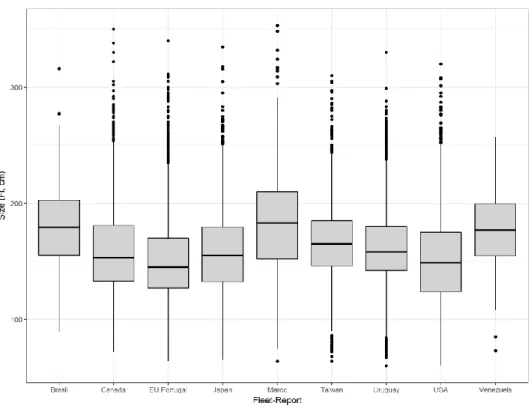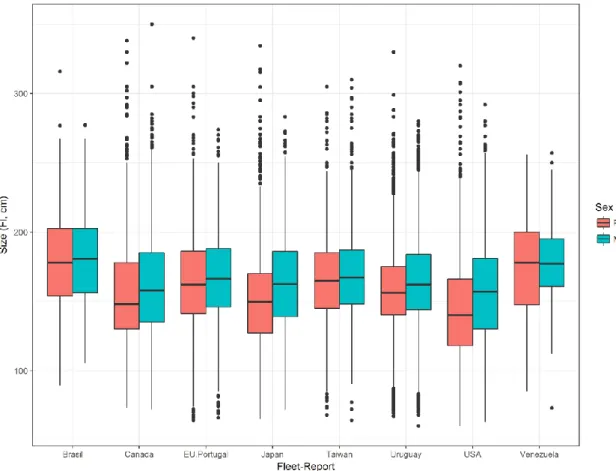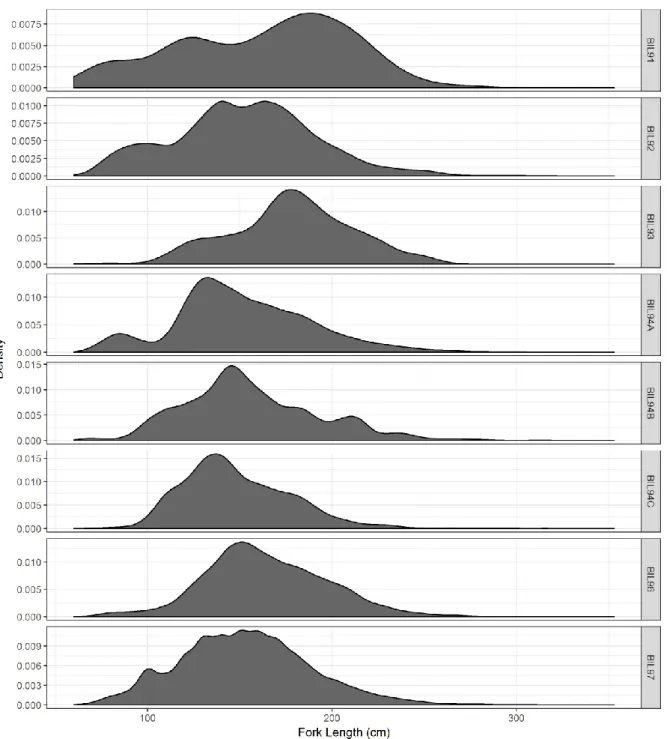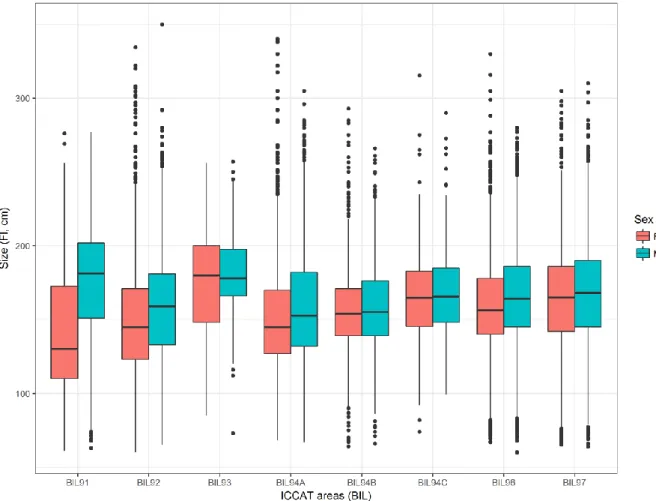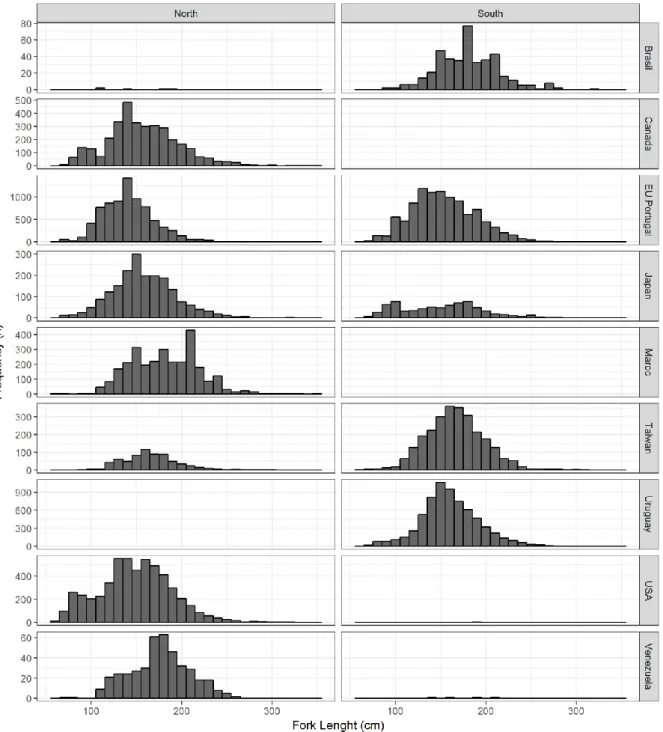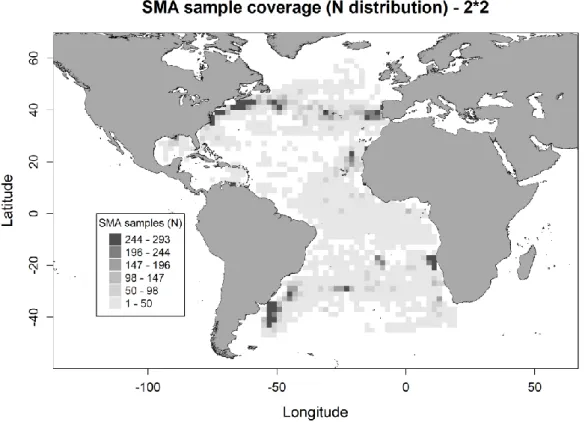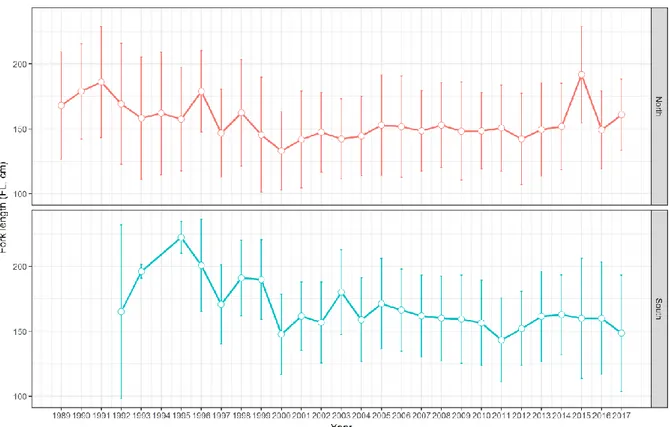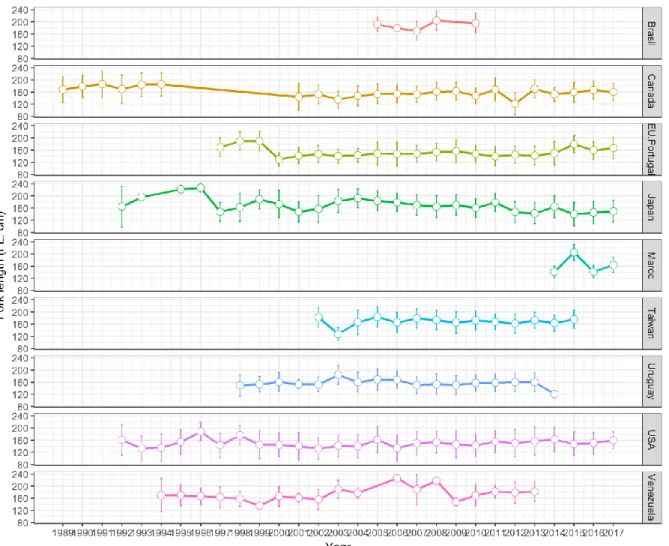SCRS/2018/096 Collect. Vol. Sci. Pap. ICCAT, 75(3): 476-492 (2018)
AN UPDATED REVISION OF SHORTFIN MAKO SIZE
DISTRIBUTIONS IN THE ATLANTIC
R. Coelho1,, A. Domingo2, D. Courtney3, E. Cortés3, F. Arocha4, K-M. Liu5,
K. Yokawa6, S. Yasuko6, F. Hazin7, H. Bowlby8, N. Abid9, D. Rosa1, P.G. Lino1
SUMMARY
As part of an ongoing cooperative program for fisheries and biological data collection within the ICCAT Sharks Working Group, information collected by fishery observers and scientific projects from several fishing nations in the Atlantic were analyzed. Datasets included information on geographic location, size and sex. A total of 42,979 shortfin mako records collected between 1989 and 2017 were compiled. Sizes considered ranged between 60 and 353 cm FL (fork length). Of those, sex information was available for 24,316 specimens. Considerable variability was observed in the size distribution by region and season, with larger sizes tending to occur in equatorial and tropical regions and smaller sizes in higher latitudes. Variability between coastal and more oceanic waters is also likely. Most fleets showed unimodal distributions, but in some cases there were bimodal patterns. The distributional patterns presented in this study provide an advance in the understanding of shortfin mako size distribution in the Atlantic, and can be used in the next update of the ICCAT shortfin mako stock assessment.
RÉSUMÉ
Dans le cadre d’un programme de coopération continu axé sur la collecte des données halieutiques et biologiques au sein du groupe d’espèces sur les requins de l’ICCAT, des informations recueillies par des observateurs des pêches et dans le cadre de projets scientifiques de plusieurs nations de pêche de l’Atlantique ont été analysées. Les jeux de données contenaient des informations sur l'emplacement géographique, la taille et le sexe. Au total, 42.979 registres de requin taupe bleu recueillis entre 1989 et 2017 ont été analysés. Les tailles enregistrées oscillaient entre 60 et 353 cm FL (longueur à la fourche). Parmi ceux-ci, l’information sur le sexe était disponible pour 24.316 spécimens. Une variabilité considérable a été observée dans la distribution des tailles par région et saison, les plus grandes tailles tendant à se produire dans les régions équatoriales et tropicales et les tailles plus petites dans des latitudes plus élevées. Il existe probablement une variabilité entre les eaux côtières et les eaux plus océaniques. La plupart des flottilles présentaient des distributions unimodales, tandis que dans certains cas des schémas bimodaux ont été observés. Les schémas de distribution présentés dans cette étude offrent une avancée dans la compréhension de la distribution des tailles du requin-taupe bleu dans l’Atlantique et peuvent être utilisés dans la prochaine actualisation de l’évaluation du stock de requin-taupe bleu de l’ICCAT.
RESUMEN
Como parte de un programa colaborativo en curso para la recopilación de datos biológicos y pesqueros en el seno del Grupo de especies de tiburones de ICCAT, se analizó la información recopilada por los observadores pesqueros y en el marco de proyectos científicos de varias naciones pesqueras del Atlántico. Los conjuntos de datos incluían información sobre la
1 Portuguese Institute for the Ocean and Atmosphere (IPMA, I.P.). Avenida 5 de Outubro s/n, 8700-305 Olhão, Portugal. Corresponding author: Rui Coelho (IPMA): rpcoelho@ipma.pt
2 Dirección Nacional de Recursos Acuáticos (DINARA), Laboratorio de Recursos Pelágicos. CP 11200 Montevideo, Uruguay.
3 National Oceanographic and Atmospheric Administration, National Marine Fisheries Service (NOAA-NMFS). Southeast Fisheries Science Center, Panama City Laboratory, Panama City, Florida 32408, USA.
4 Instituto Oceanográfico de Venezuela, Universidad de Oriente, Av. Universidad, Cumaná-6101, Estado Sucre, Venezuela. 5 Institute of Marine Affairs and Resource Management. National Taiwan Ocean University, Keelung 202, Taiwan.
6 National Research Institute of Far Seas Fisheries (NRIFSF). 5-7-1 Orido, Shimizu-ku, Shizuoka-City Shizuoka 424 8633, Japan.
7 Departamento de Pesca e Aquicultura, Universidade Federal Rural de Pernambuco, Av. Dom Manoel de Medeiros, s/n., Dois Irmãos, CEP: 52.171-030, Recife, PE, Brasil.
ubicación geográfica, talla y sexo. Se analizaron un total 42.979 registros de ejemplares de marrajo dientuso recogidos entre 1989 y 2017. Las tallas consideradas oscilaron entre 60 y 353 cm FL (longitud a la horquilla). Entre estos, se dispuso de información sobre sexos para 24.316 ejemplares. Se observó una considerable variabilidad en la distribución de tallas por región y temporada, en la que las tallas más grandes tendían a observarse en las regiones ecuatorial y tropical y las tallas más pequeñas en latitudes más altas. También es probable que exista variabilidad entre las aguas costeras y más oceánicas. La mayoría de las flotas presentaban distribuciones unimodales, pero en algunos casos existían patrones bimodales. Los patrones de distribución presentados en este estudio proporcionan una mejor comprensión de los diferentes aspectos de la distribución de tallas del marrajo dientuso en el Atlántico, y pueden utilizarse en la próxima actualización de la evaluación de stock de marrajo dientuso de ICCAT.
KEYWORDS
Sex ratios, size distribution, shortfin mako, spatial distribution
1. Introduction
The shortfin mako is a widespread pelagic shark species that occurs in temperate and tropical waters of all oceans from about 60ºN to 50°S (Compagno, 2001). Like other Lamnidae sharks, it is an endothermic species that uses a heat-exchanging circulatory system to maintain muscle and visceral temperatures above those of the surrounding water, which allows for a higher level of activity (Carey et al., 1981; Bernal et al., 2001). Tagging studies in the northwest Atlantic have shown that shortfin makos can make extensive migrations of more than 3,000 km (Casey and Kohler, 1992), even though they do not seem to be as common as in the blue shark. The shortfin mako is one of the most valuable shark species for its high quality meat, which can be utilized fresh, frozen, smoked and dried-salted for human consumption. Big-game sports angling for this species is widespread, and shortfin makos have become the subject of ecotourism diving in some areas in recent years (Compagno, 2001). The shortfin mako is an important and valuable species for pelagic longlines, drifting and set gillnets and hook-and-line fisheries. The Ecological Risk Assessments carried out for pelagic sharks in the Atlantic in 2010 and 2012 (Cortés et al., 2010; Cortés et al., 2012) showed that the shortfin mako was one of the most vulnerable of all species analyzed, due to its relatively low productivity and high susceptibility.
The last Atlantic shortfin mako assessment (North and South Atlantic stocks) was carried out in 2017 (Anon., 2017). For the North Atlantic the various alternative models indicated that the stock abundance was below (production models) or very close (age-structured model) to BMSY and that F was overwhelmingly above FMSY,
with a combined 90% probability of being in an overfished state and experiencing overfishing. For the South Atlantic stock, the various models showed a combined probability of 32.5% of being overfished and 41.9% of experiencing overfishing. Especially for the South Atlantic stock, results were highly uncertain due to conflict between catch and CPUE data.
Following this last 2017 stock assessment, the ICCAT Commission established a new Recommendation regarding conservation and management of shortfin makos [ICCAT Rec. 2017-08], establishing alternatives for future catches and/or minimum landing sizes. This new ICCAT Recommendation also requests the SCRS to continue the scientific work on shortfin mako shark and an update of the assessments for 2019.
Therefore, the main objective of this paper is to update the detailed size distribution information from the major longline fleets that target tunas or swordfish in the Atlantic and capture shortfin mako as bycatch, aiming to continue the work requested by this new ICCAT Recommendation. Specific objectives of the paper are to 1) analyze the distribution and seasonal patterns of the shortfin mako, 2) provide time series trends by region and fleet and 3) analyze the distribution of the sex ratios.
2. Materials and methods
Shortfin mako records and data were recorded by scientific observers, port and market samplers working on national data collection programs and scientific projects. Data came from IPMA (Portuguese Institute for the Ocean and Atmosphere), DINARA (Dirección Nacional de Recursos Acuáticos), Taiwan Fisheries Agency, NOAA/NMFS (National Marine Fisheries Service), NRIFSF (National Research Institute of Far Seas Fisheries), the Brazilian Observer Program, Venezuela (ICCAT’s EPBR-Venezuelan Pelagic Longline Observer Program), the Canadian At-sea Observer Program and the Moroccan National Institute for Fishery Research (INRH) market sampling program.
Data were collected across a wide geographical range. For analysis purposes, the two hemispheres (stocks) were separated at the 5ºN parallel, as recommended in the ICCAT Manual for shark species (ICCAT, 2006-2016). Furthermore, the study area was divided into eight major areas taking into consideration the ICCAT sampling areas for sharks (ICCAT, 2006-2016).
For captured specimens, data on specimen size, sex, capture location and date was recorded. For market sampling, the size and 5*5 locations were obtained. The size measurement most often taken was the fork length (FL), but there were some exceptions as some of the national programs also record other measurements (e.g., precaudal length, total length, weight). In those cases, all sizes and weights were converted to FL using equations recommended by the ICCAT Sharks working group (Anon., 2014).
Sizes below 60 cm FL were filtered and excluded from the analysis considering that the size at birth of the species is around 60-65cm FL.
Specimen sizes were compared between regions, sexes and quarters of the year using non-parametric k-sample permutation tests (Manly, 2007). The size distributions were plotted and compared between years, fleets and stocks. The annual trends of the mean catch-at-size were also plotted and analyzed for fleets and stocks. The sex ratios were calculated and plotted using 5*5 degree squares.
All analysis for this paper was carried out using the R language for statistical computing version 3.4.4. (R Core Team, 2018).
3. Results
3.1 Size distribution
A total of 42,979 shortfin mako shark specimens were recorded, reported and considered within the scope of this study (Table 1). The specimens sizes considered ranged from 60 to 353 cm FL, covering a wide range of the species size range (Figure 1, Figure 2).The median sizes and inter-quartile ranges tended to be larger for the males compared to females (Figure 3).
Considerable variability was observed in the size distribution of males and females in the various Atlantic regions (Figure 4). In areas such as BIL91, BIL 92 (NW-Atl) and BIL94A (N-central Atl) there was considerable variability between males and females (Figure 5). In other areas such as BIL94B and BIL94C (NE-Atl) and BIL96 and BIL97 (South-(NE-Atl) the size differences between sexes were less evident. The largest median sizes for both sexes occurred in area BIL93 in the NW-Atl (Figure 5). In terms of size distribution, for most fleets and both stocks the size data seemed unimodal, except in some cases (e.g., Canada and the USA in the North Atl) where some bimodal distribution is apparent (Figure 6).
The effort coverage (N size samples available) and the median size in 2*2 degrees are provided in Figure 7 and Figure 8, respectively.
3.2 Annual trends in the size distributions
The time series of the catch at size was relatively stable for the North Atlantic. In contrast, there was a general decreasing trend in the South Atlantic (Figure 9). There was considerable variability in the time series trends by fleet, which are shown in Figure 10.
3.3 Distribution of the sex ratios
Of the overall shortfin mako size data, 24,316 specimens had the sex recorded. Of those, 10,948 (45.0%) were females and the remaining 13,368 (55.0%) were males. There were some apparent sex-ratio segregations, for example with more males in the NW and SW regions, and more females in the tropical NE (Figure 11). In some areas of the Atlantic there was variability in the sex ratios according to the season (Figure 12).
4. Discussion
This work provides an update of the ongoing revision for shortfin mako size distribution using data from fishery observer programs of the Atlantic Ocean and represents an important contribution to the study of the spatial and seasonal dynamics of this species.
There seems to be some latitudinal distribution of the shortfin mako in the Atlantic, with the larger specimens tending to occur along the equatorial and tropical regions and the smaller sizes occurring mainly towards higher latitudes, both in the North and Southern hemispheres. This pattern is similar to what was found for the blue shark (Coelho et al., 2018), but opposite to other pelagic shark species as the bigeye thresher (Fernandez-Carvalho et al., 2015).
Casey and Kohler (1992) suggested that the core distribution of shortfin makos in the northwest Atlantic is between 20-40°N bordered by the Gulf Stream in the west and the mid-Atlantic ridge in the east. In the northeast Atlantic it is presumed that the Strait of Gibraltar might be a nursery ground (Buencuerpo et al., 1998; Tudela et al., 2005). The area between 17° to 35°S off the coast of Brazil seems to be an area of birth, growth and mating in the southwest Atlantic (Amorim et al., 1998). Our study extends those previous observations from other authors, as the entire temperate area of the North and Central Atlantic seems to be a nursery for the species, especially the areas closer to continental and insular shelf waters. In the South Atlantic, both the southeast and southwest areas also seem to be nurseries for the species due to the large proportions of juveniles.
One issue that will need to be addressed in the future is the fact that different fleets might record sizes differently, especially using strait line measurements versus curved over the body measurements. This will be specified for each fleet individually and then corrected at a later stage.
It is important to note also that the data used in our study comes from several different fleets, with different fishing métiers that target different species, and, as such, the size ranges and abundance reported by each fleet for each region are also affected by fleet distribution and selectivity. Additionally, some of the variability observed in the fleet time-series analysis may be explained by lower sample sizes in some years. While our study provides a general overview of the size distribution at a wide Atlantic scale, it is worth noting that there are probably finer scale effects and local variability patterns taking place that are not likely to be captured in such large scale analyses. Therefore, this study is important as a general overview and provides the general trends in the Atlantic, but it is also important to continue more detailed and local analyses for specific regions of the Atlantic.
These general distributional patterns presented can be used in future stock assessments of the species, particularly for the updates being planned for 2019, and help managers adopt more informed and efficient conservation measures.
5. Acknowledgments
This work was carried out as part of a cooperative study conducted by the ICCAT Shark species group. Sampling and data collection from the Portuguese fishery were obtained and funded within the scope of the EU Data Collection Framework. Sampling from Uruguay was conducted by fishery observers from PNOFA. Sampling from Venezuela was conducted by scientific observers of the ICCAT sponsored Enhanced Program for Billfish Research (EPBR) in Venezuela. The authors are grateful to all the fishery observers and longline skippers from the nations involved in this study. R. Coelho is supported by an Investigador-FCT contract from the Portuguese Foundation for Science and Technology (FCT, Fundação para a Ciência e Tecnologia) supported by the EU European Social Fund and the Programa Operacional Potencial Humano (Ref: IF/00253/2014). In Brazil, the work was made possible by the Special Secretariat of Aquaculture and Fisheries.
References
Amorim, A.F., Arfelli, C.A., Fagundes, L. 1998. Pelagic elasmobranchs caught by longliners off southern Brazil during 1974-97: an overview. Marine and Freshwater Research, 49: 621-632.
Anon. 2017. Report of the 2017 ICCAT shortfin mako assessment meeting. Madrid. ICCAT - International Commission for the Conservation of Atlantic Tunas, 12-16 June, Madrid, Span. 64 pp.
Anon. 2014. Shark Species Group Inter-Sessional Report. ICCAT - International Commission for the Conservation of Atlantic Tunas. March 10-14, 2014, Piriapolis, Uruguay. 11 pp + 21 appendices.
Bernal, D., Dickson, K.D., Shadwick, R.E., Graham, J.B. 2001. Analysis of the evolutionary convergence for high performance swimming in lamnid sharks and tunas. Comparative Biochemistry and Physiology, 129: 695-726.
Buencuerpo, V., Rios, S., Moron, J. 1998. Pelagic sharks associated with the swordfish, Xiphias gladius, fishery in the eastern North Atlantic Ocean and the Strait of Gibraltar. Fishery Bulletin, 96: 667-685.
Carey, F.G., Teal, J.M., Kanwisher, J.W. 1981. The visceral temperature of mackerel sharks (Lamnidae). Physiological Zoology, 54: 334-344.
Casey, J.G., Kohler, N.E. 1992. Tagging studies on the shortfin mako shark (Isurus oxyrinchus) in the western North Atlantic. Australian Journal of Marine and Freshwater Research, 43: 45-60.
Coelho, R., Mejuto, J., Domingo, A., Yokawa, K., Liu, K-M., Cortés, E., Romanov, E., da Silva, C., Hazin, F., Arocha, F., Mwilima, A.M., Bach, P., Ortiz de Zarate, V., Roche, W., Lino, P.G., García-Cortés, B., Ramos-Cartelle, A.M., Forselledo, R., Mas, F., Ohshimo, S., Courtney, D., Sabarros, P.S., Perez, B., Wogerbauer, C., Tsai, W-P., Carvalho, F., Santos, M.N. 2018. Distribution patterns and population structure of the blue shark (Prionace glauca) in the Atlantic and Indian Oceans. Fish and Fisheries, 19: 90– 106.
Compagno, L.J.V. 2001. Sharks of the world. An annotated and illustrated catalogue of shark species known to date. Vol. 2. Bullhead, Mackerel and Carpet Sharks (Heterodontiformes, Lamniformes and Orectolobiformes). FAO, Rome. 269pp.
Cortés, E., Arocha, F., Beerkircher, L., Carvalho, F., Domingo, A., Heupel, M., Holtzhausen, H., Santos, M.N., Ribera, M., Simpfendorfer, C. 2010. Ecological risk assessment of pelagic sharks caught in Atlantic pelagic longline fisheries. Aquatic Living Resources, 23: 25-34.
Cortés, E., Domingo, A., Miller, P., Forselledo, R., Mas, F., Arocha, F., Campana, S., Coelho, R., Silva, C.D., Holtzhausen, H., Keene, K., Lucena, F., Ramirez, K., Santos, M.N., Semba-Murakami, Y., Yokawa, K. 2012. Expanded ecological risk assessment of pelagic sharks caught in Atlantic pelagic longline fisheries. ICCAT Sharks Working Group, SCRS Document, SCRS/2012/167. 55pp.
Fernandez-Carvalho, J., Coelho, R., Mejuto, J., Cortés, E., Domingo, A., Yokawa, K., Liu, K.M., García-Cortés, B., Forselledo, R., Ohshimo, S., Ramos-Cartelle, A.M., Tsai, W.P., & Santos, M.N. 2015. Pan-Atlantic distribution patterns and reproductive biology of the bigeye thresher, Alopias superciliosus. Reviews in Fish Biology and Fisheries, 25: 551–568.
ICCAT. 2006-2016. ICCAT Manual. International Commission for the Conservation of Atlantic Tuna. In: ICCAT Publications [on-line]. Updated 2016. http://www.iccat.int/en/ICCATManual.htm.
R Core Team. 2018. R: A language and environment for statistical computing. R Foundation for Statistical Computing, Vienna, Austria. URL http://www.R-project.org/.
Tudela, S., Kai, A., Maynou, F., El Andalossi, M., Guglielmi, P. 2005. Driftnet fishing and biodiversity conservation: the case study of the large-scale Moroccan driftnet fleet operating in the Alboran Sea (SW Mediterranean). Biological Conservation, 121: 65-78.
Table 1. Current sample available for the revision of the shortfin mako size distributions in the Atlantic, by fleet and year.
Figure 1. Location and catch size distributions (FL, cm) of the shortfin mako (Isurus oxyrinchus) recorded for this study in the Atlantic Ocean. The color scale of the dots represents specimen sizes, with darker colors representing smaller specimens and lighter colors larger specimens. The categorization of size classes for the map was carried out using the 0.2 quantiles of the data. The ICCAT sampling areas for BIL/Sharks are identified (black lines). NOTE: locations shown in the map are jittered by up to 1*1 degrees.
Figure 2. Boxplots with the size distribution of the shortfin mako size ranges from the various fleets. The middle bar represents the median, the box represents the inter-quartile range, the vertical lines represent the non-outlier range and the points represent outliers.
Figure 3. Boxplots with the size distribution of the shortfin mako size ranges from the various fleets, categorized by sex. In each boxplot the middle bar represents the median, the box represents the inter-quartile range, the vertical lines represent the non-outlier range and the points represent outliers.
Figure 5. Boxplots with the size distribution of the shortfin mako size ranges from the various ICCAT sampling regions for BILL/Sharks, categorized by sex. In each boxplot the middle bar represents the median, the box represents the inter-quartile range, the vertical lines represent the non-outlier range and the points represent outliers.
Figure 6. Size-frequency distributions of shortfin mako by fleet and hemisphere in the Atlantic Ocean. Note the different scales in the Y axis.
Figure 9. Times series of the mean sizes of shortfin mako in the two stock areas (north and south Atlantic, separated by 5ºN) during the period 1989-2017. The error bars are ± 1 standard deviation.
Figure 10. Times series of the mean sizes of shortfin mako by the various fleets (period of the time series is specific for each fleet). The error bars are ± 1 standard deviation.
Figure 11. Shortfin mako sex ratios recorded in 5ºx5º squares during this study (period 1989-2017). Circle sizes are proportional to the sample size (N) in each square.
Figure 12. Shortfin mako sex ratios recorded in 5ºx5º squares during this study in each quarter of the year (period 1989-2017).
